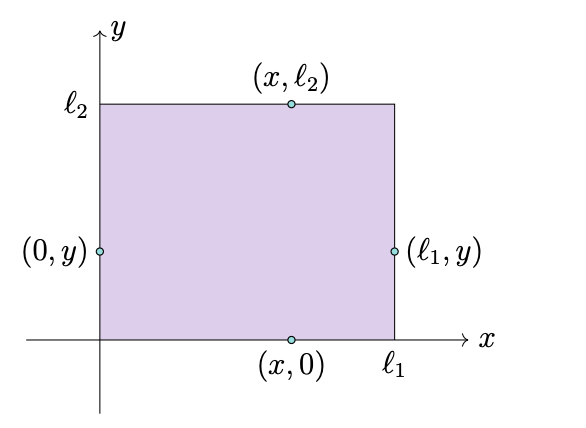what if heat, but plate
\begin{equation} \pdv{u}{t} = \pdv[2]{u}{x} + \pdv[2]{u}{y} \end{equation}
For some heat distribution that has arbitrary shape, on some domain \(\Omega \times [0, \infty]_{t}\) (i.e. argumentation of some space dimensions by time).
- Dirichlet Conditions: edges have heat \(0\)
- OR Neumann Conditions: normal derivative (flux) is \(0\) at the edge
If \(\Omega\) is a general blob, you are actually kinda fucked. Because the bounds on \(x\) depend on \(y\), and \(y\) on \(x\), so you can’t just separate them into a product.
However, if we cut a rectangle, life is better.

where:
\begin{equation} 0 \leq x \leq l_1 \end{equation}
\begin{equation} 0 \leq y \leq l_2 \end{equation}
where the Dirichlet condition is now described as the four line segments along the curve at \(l_1\) and \(l_2\) having constant (or vanishing) temperature.
Its general solution is:
\begin{equation} u(t,x,y) = \sum_{n_1=1}^{\infty}\sum_{n_2=1}^{\infty} A_{n_1, n_2} e^{-\qty(\qty( \frac{{n_{1}}^{2}}{{l_{1}}^{2}}) + ( \frac{{n_{2}}^{2}}{{l_{2}}^{2}})) \pi^{2}t} \sin \qty(\qty(n_1 \frac{\pi}{l_{1}})x )\sin \qty(\qty(n_2 \frac{\pi}{l_{2}})y ) \end{equation}
where:
\begin{equation} \lambda = \lambda_{1} + \lambda_{2} = - \qty( \frac{{n_{1}}^{2}}{{l_1}^{2}} + \frac{{n_{2}}^{2}}{{l_2}^{2}}) \pi^{2} \end{equation}
solving
\begin{equation} U(t,x,y) = A(t)B(x)C(y) \end{equation}
So now with much prayer and plugging:
\begin{equation} A’(t) B(x) C(y) = A(t) B’’(X)C(y) + A(t)B(x)C’’(y) \end{equation}
which gives:
\begin{equation} \frac{A’(t)}{A(t)} = \frac{B’’(x)}{B(x)} + \frac{C’’(y)}{C(y)} = \lambda \end{equation}
Which causes two problems to arise:
\begin{equation} \begin{cases} A’(t) = \lambda A(t) = 0 \\ \frac{B’’(x)}{B(x)} + \frac{C’’(y)}{C(y)} = \lambda \end{cases} \end{equation}
the second expression gives:
\begin{equation} \frac{B’’(X)}{B(X)} = \lambda - \frac{C’’(y)}{C(y)} \end{equation}
Meaning:
\begin{equation} \frac{B’’(X)}{B(X)} = \lambda - \frac{C’’(y)}{C(y)} = \lambda_{1} \end{equation}
Meaning:
\begin{equation} B’’(x) - \lambda_{1} B(x) = 0 \end{equation}
and:
\begin{equation} C’’(y) - \lambda_{2} C = 0 \end{equation}
where \(\lambda - \lambda_{1} = \lambda_{2}\).
Now, recall our boundary conditions:
\begin{equation} B(0) = B(l_1) = 0 \end{equation}
and
\begin{equation} C(0) = C(\lambda_{2}) = 0 \end{equation}
So, for the expression in \(B\), we obtain:
\begin{equation} \lambda_{1} = \frac{-k_{1}^{2}\pi^{2}}{l_{1}^{2}}} \end{equation}
\begin{equation} \lambda_{2} = \frac{-k_{2}^{2}\pi^{2}}{l_{2}^{2}}} \end{equation}
so:
\begin{equation} \lambda = \lambda_{1} + \lambda_{2} \end{equation}
All together, we obtain:
\begin{equation} B(x) = \sin \qty( \frac{k_{1} \pi x}{l_{1}}) \end{equation}
and:
\begin{equation} C(y) = \sin \qty( \frac{k_{2} \pi y}{l_{2}}) \end{equation}
finally, where:
\begin{equation} A’ + \qty( \frac{k_{1}^{2} \pi^{2}}{ l_1^{2}} + \frac{k_{2}^{2} \pi^{2}}{ l_2^{2}})A = 0 \end{equation}
which gives us:
\begin{equation} A(t) = e^{-\qty( \frac{k_{1}^{2} \pi^{2}}{ l_1^{2}} + \frac{k_{2}^{2} \pi^{2}}{ l_2^{2}})t} \end{equation}
so then multiply them together:
\begin{equation} \sum_{k_1}^{} \sum_{k_2}^{}E_{k_1, k_2} e^{-\qty( \frac{k_{1}^{2} \pi^{2}}{ l_1^{2}} + \frac{k_{2}^{2} \pi^{2}}{ l_2^{2}})t} \sin \qty( \frac{k_{2} \pi y}{l_{2}}) \sin \qty( \frac{k_{1} \pi x}{l_{1}}) \end{equation}
at \(u(0,x,y)\), we obtain:
\begin{equation} u(0,x,y) = \sum_{k_1}^{} \sum_{k_2}^{}E_{k_1, k_2} \sin \qty( \frac{k_{2} \pi y}{l_{2}}) \sin \qty( \frac{k_{1} \pi x}{l_{1}}) \end{equation}
for every \(f(x,y)\), we can solve for \(E_{k_1, k_2}\) by fixing \(y\), for instance, then writing a Fourier series as a function that depends on the coefficients you left out. This gives:
\begin{equation} f(x,y) = \sum a_{k_1}(y) \sin \qty( \frac{k_1 \pi x}{l_1}) \end{equation}
and then, each of THESE internal functions a function \(a_{k_1}(y)\) , which you can obtain over \(y\) and expand as a fourier series.
To solve for each, you do the susual:
\begin{equation} a_{k_1}(y) = \frac{2}{l_1} \int_{0}^{l_1} f(x,y) \sin \qty( \frac{k_1 \pi x}{l_1}) \dd{x} \end{equation}
which you can expand:
\begin{equation} E_{k_1, k_2} = \frac{2}{l_2} \int_{0}^{l_2} a_{k_1}(y) \sin \qty( \frac{k_1 \pi y}{l_2}) \dd{y} \end{equation}
which means that, substituting it in, the whole thing can be written together as:
\begin{equation} E_{k_1, k_2} = \frac{2}{l_2} \int_{0}^{l_2} \frac{2}{l_1} \int_{0}^{l_1} f(x,y) \sin \qty( \frac{k_1 \pi x}{l_1}) \dd{x} \sin \qty( \frac{k_1 \pi y}{l_2}) \dd{y} \end{equation}